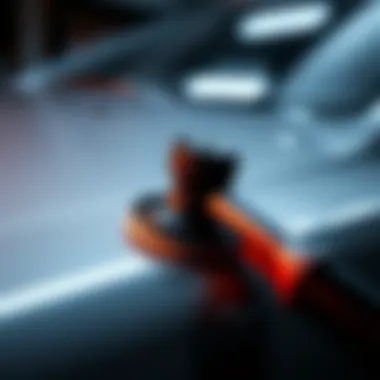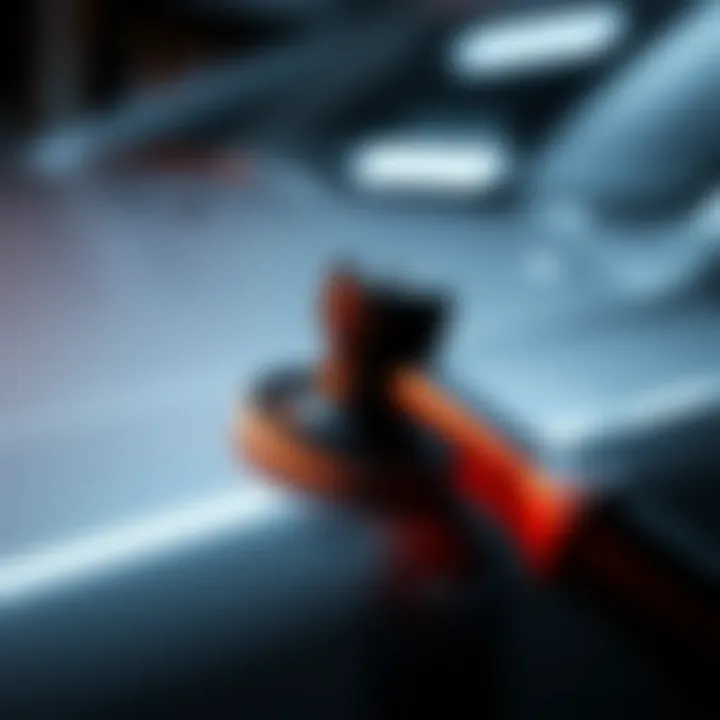Effective Techniques to Buff Car Scratches Away


Intro
Car scratches can be a source of frustration for many vehicle owners. When the shiny coat of paint gets marred by an unsightly scratch, it not only diminishes the aesthetic appeal of the car but can also depreciate its value. Luckily, there are a variety of methods available to buff out these imperfections, ranging from simple DIY techniques to professional services.
Understanding the methods to remove scratches is crucial for anyone looking to maintain the integrity and appearance of their vehicle. Not only does this knowledge enable car owners to restore their car’s finish, but it also enhances their overall experience with vehicle ownership. This guide aims to equip readers with detailed insights into the best practices for scratching repair, exploring various techniques and tools that can help rejuvenate a car's surface effectively.
Now, let’s dig into an overview of the current market regarding car scratch repair.
Understanding Car Scratches
When it comes to maintaining the aesthetic appeal of your vehicle, understanding car scratches is a fundamental aspect. Not only do scratches mar the appearance of your automobile, but they can also indicate potential long-term damage if left untreated. So, knowing how to identify and categorize these nuisances is essential for effective remediation.
Types of Scratches
There are several varieties of scratches you might encounter, and recognizing each type can dramatically influence how you respond to them.
Surface Scratches
Surface scratches are perhaps the most common form of blemish on a car's finish. These often result from everyday occurrences like brushing against a branch or improper washing techniques. The hallmark of a surface scratch is that it typically affects only the clear coat layer, leaving the underlying paint intact. This characteristic makes them a prime target for buffing and polishing, which can restore your car to near showroom quality.
The advantage here is that these scratches are usually the easiest to fix. A simple buffing with a polishing compound and a soft cloth might do the trick, making it a popular choice for DIY enthusiasts looking to quickly enhance their vehicle's look without resorting to professional help.
Deeper Scratches
In contrast, deeper scratches penetrate beyond the clear coat into the paint itself, often requiring more specialized treatment. These abrasions can occur from gravel roads or accidental scrapes against other vehicles. The distinctive feature of a deeper scratch is that you may see the primer or metal underneath, which indicates a more serious issue.
Fixing such damage is generally more complex, often necessitating not just buffing, but potentially touch-up paint or a complete respray. The downside of tackling deeper scratches is the time and skill required—this often pushes car owners to seek professional assistance.
Keying and Vandalism
Keying, or intentional scratching of a vehicle, adds a different layer to the scratch saga. Such vandalism often creates jagged and deep grooves in the paint, making them rather challenging to fix. The key characteristic of these scratches is their irregular shape and depth, which obviously differs from accidental scratches.
Dealing with scratch marks from keying can be particularly frustrating, as these marks are not only unsightly but can also affect your car’s resale value. Furthermore, returning the car’s appearance to its original state can be costly, often requiring a full repaint in that specific area or even additional surface treatment.
Assessing the Damage
Identifying the type of scratch is only half the battle; the next step is to assess the damage accurately. This assessment helps in determining the right steps to take for restoration.
Visual Inspection
A visual inspection can unearth telltale signs of scratches. This process involves examining the surface for any discoloration or texture differences.
A key advantage of visual inspection is its simplicity; it requires no specialized tools and can be done anywhere. However, it is limited by human perception and may sometimes miss finer details.
Depth Test
To get a better handle on how deep a scratch goes, a depth test can provide more concrete insight. Gently running your fingernail over the scratch can hint at its severity—if your nail catches, you’re likely dealing with a deeper scratch.
While this method is generally effective, it does necessitate a bit of caution; too aggressive of a technique could worsen the scratches or even cause more damage.
Lighting Considerations
Finally, the lighting conditions during your assessment play a critical role. Natural sunlight can magnify imperfections, making it easier to spot scratches that may not be noticeable under artificial light.
A well-lit environment allows for a thorough inspection, revealing both the visible and less obvious flaws in your paintwork. However, poor lighting can mask problems, so it’s wise to take your time and choose your inspection setting carefully.
Remember, proper evaluation is key to ensuring the right treatment, enhancing not just the look of your car but also its longevity.
Preparing for the Buffing Process
Before diving headfirst into buffing out those scratches, it’s paramount to lay the groundwork properly. Preparing for the buffing process is like getting ready for a big exam; you wouldn't walk in unprepared.
The importance of this stage cannot be overstated. Jumping into the buffing without proper preparation can lead to unsatisfactory results or, worse, additional damage. It’s not just about slapping some polish on and hoping for the best. It involves gathering the right tools, ensuring a safe environment, and making sure that your workspace is conducive to achieving the smoothest finish possible.
Gathering Necessary Tools
Equipping yourself with the necessary tools is crucial for a successful buffing session. Whether you're an amateur or a seasoned veteran, having the right gear helps the process become so much easier and more efficient.
Polishing Compound
A quality polishing compound is at the heart of the buffing process. Think of it as the magic potion that will breathe new life into your car’s surface. This compound is specifically designed to remove small scratches and restore the shine.
One key characteristic of a good polishing compound is its abrasive quality. What makes it a popular choice is its effectiveness in gently leveling the scratch and refining the surface. However, you should know that using the wrong compound can cause more problems than it solves. Some compounds work well on certain finishes while not so much on others. So, picking the right one for your specific car finish, whether it be metallic or matte, is absolutely essential.


Advantages of choosing the right polishing compound include:
- Effective Scratch Removal – The right compound targets scratches effectively.
- Ease of Use – Many polishing products are user-friendly, making them accessible.
Buffering Tools
Now that you have your compound, let’s talk about the tools you’ll use to apply it. Buffering tools, especially powered ones, are game-changers. They can save time and effort, yielding a more professional-looking finish.
A key feature of quality buffering tools is their ease of operation. Whether one opts for a rotary buffer or a dual-action polisher, both can be beneficial. The difference lies in their operation: a rotary buffer spins at a constant speed, while a dual-action polisher oscillates, which reduces the risk of damaging the surface.
It's worth mentioning that both types of buffers come with their pros and cons. Rotary buffers can achieve greater cutting power but may also scorch or damage surfaces if not handled properly. Conversely, dual-action polishers tend to be safer for amateurs, though they may require slightly more time to achieve the desired results.
Cleansing Materials
Cleansing materials are fundamental but often overlooked. These are the products that will allow you to prepare the surface before engaging with the polishing compound. Clean, debris-free surfaces are essential before you start buffing to avoid creating additional scratches.
A notable characteristic of good cleansing materials is their thoroughness. They should effectively remove dirt and grime without leaving residues behind. Commonly, car soaps or specialized automotive cleansers are advisable for this purpose.
The unique feature to look for in cleansing materials is their pH-balance. Alkaline cleaners can harm the car’s paint, so it’s vital to stick to pH-balanced options. The advantage is clearer: a clean surface means a successful buffing process ahead, reducing the risk of damage or unforeseen issues.
Creating a Safe Working Environment
Creating a safe environment for doing your buffing is just as important as having the right tools. It ensures that not only you are protected but also that the buffing process can be conducted effectively and without interruptions.
Choosing the Right Location
The location you select can significantly impact your buffing results. A clean, well-lit area is ideal. If you can, try to avoid working outdoors on windy days, as dust and debris can create new scratches, defeating the purpose of your efforts.
A well-chosen location such as a garage will help minimize these risks. Additionally, it allows for a controlled environment where temperature and humidity won’t play spoilsport. This can actually enhance the performance of your polish and achieve a far better finish.
Lighting Requirements
Proper lighting is a key factor in ensuring you don’t miss any scratches. Buffing under inadequate light could result in overlooking imperfections, leaving your work half-done.
Having bright, even lighting will let you see every blemish clearly. LED work lights are a great option as they provide excellent illumination. Ensure you’re not casting shadows either, as these can obscure flaws on the car's surface.
Protective Gear
Don’t forget about your safety. While buffing can be a straightforward task, it isn’t without its risks. Dust, chemical fumes from compounds, and even flying debris can potentially be harmful.
Utilizing protective gear such as gloves, goggles, and even a mask can make a notable difference. A mask will help filter fine particles, while goggles protect your eyes from splashes of chemicals. The unique aspect of protective gear isn't just about safeguarding yourself; it enhances your focus on the task at hand, permitting a more enjoyable and safe buffing experience.
Preparing for the buffing process may seem laborious, but each of these steps sets the stage for success. From gathering the right tools to ensuring a safe workspace, proper preparation can literally transform your car into a shining beauty again. Engage thoughtfully with each stage, and your efforts will be rewarded with results you'll be proud of.
Step-by-Step Buffing Process
When tackling scratches on your car, having a well-defined, step-by-step buffing process is essential. This not only ensures that you achieve the best results, but also helps you avoid potential mishaps that could lead to further damage. It's like preparing a delicious recipe; if you don’t follow each step carefully, the final dish might turn out less than appetizing. A systematic approach to buffing scratches provides clarity, minimizes errors, and produces a polished finish for your vehicle. Here, we will explore the meticulous steps involved in buffing out scratches, starting from preparing the surface to the actual buffing techniques.
Surface Preparation
Washing the Car
Washing the car might seem like an obvious step, but it's crucial to understand its significance. It's the foundation upon which the entire buffing process relies. Grit and grime left on the surface can lead to scratches during buffing. So, this step is about more than just appearances—it’s about protection. When you wash your car, use a gentle soap and soft sponge, ensuring all dirt is removed, especially around the scratches. This method isn't just personal preference; it's widely recognized as a best practice.
A clean car surface allows the polishing compound to bond well, which can enhance the effectiveness of the buffing process. Neglecting this might mean wasting time later on. A thorough wash can also highlight any other imperfections you might not have noticed before, giving you a complete picture of what needs to be tackled.
Drying Techniques
Drying the car properly is just as important as washing it. If you don't dry it effectively, water spots can form and make your vehicle look worse than before. Using a microfiber towel is a go-to choice among enthusiasts. These towels are soft and absorbent, effectively trapping water without scratching the paint.
The unique aspect of this step is that it can directly affect the application of the polishing compound. Any leftover moisture can lead to uneven application, resulting in a patchy finish. So, drying well makes a world of difference in the overall final result of the buffing process.
Masking Off Areas
Masking off areas you don’t want to buff is a crucial step that many first-timers may overlook. This involves using masking tape to cover trims, rubber seals, and any sensitive areas on the car. This step is essential to protect these spaces from the buffing compound that could permanently damage them.
Why is it beneficial? Well, it enhances precision during the buffing process. You’re not only buffing the scratch but also ensuring the surrounding areas remain pristine. This technique means you can focus on the scratched spots without the worry of hitting other surface areas.
Applying Polishing Compound
Choosing the Right Compound
Picking the proper polishing compound is a linchpin in the buffing process. Different compounds are designed for various levels of scratches, so it’s really about matching the right treatment to the damage at hand. A good rule to follow is to choose a compound that is specifically designed for automotive finishes.
The key feature here is the abrasiveness—some compounds are more aggressive than others. This can be beneficial if you’re dealing with deeper scratches, but for surface scratches, a less abrasive compound is preferable. Additionally, it’s often recommended to do a little research or test with a small area to see how the compound interacts with your specific car's finish, avoiding any nasty surprises.


Proper Application Techniques
With the compound selected, understanding the right technique to apply it is where the skills come in. Generally, applying a small amount on a buffer pad and working it into the scratch area in circular motions is the way to go. The goal is to gradually work the compound into the surface until it dissipates, which indicates that the paint is being effectively treated.
The uniqueness of this step lies in the consistency; too much pressure can lead to burns or damage, while too little won’t have any effect. So, finding that sweet spot while applying the compound is crucial for achieving desired results.
Using Buffing Pads
Buffing pads come in various types, and knowing which one to use can greatly affect the outcome. Generally, foam pads are softer, while wool pads can offer a harsher cut due to their texture. Each serves a specific purpose depending on the work that needs to be done on the car’s surface.
What sets this aspect apart is the varying material of the pads and how they interact with different compounds. After some practice, you’ll quickly realize that certain combinations yield better results, making it an essential learning journey. However, be cautious—using the wrong pad may lead to further scratches or uneven finishes.
Buffing Techniques
Manual Buffing
Manual buffing is often seen as an art form, giving some enthusiasts the satisfaction of doing things by hand. It allows for precise control, letting you focus on specific areas that need more attention. Using a non-abrasive cloth, you can apply gentle pressure to buff out imperfections.
The beauty of manual buffing is that it bestows a sense of intimacy with the vehicle; you’re directly engaged with its surface. However, it can be labor-intensive, requiring more time and effort compared to machine buffing.
Using a Dual-Action Polisher
A dual-action polisher is like a dream come true for anyone looking to make their buffing experience snappier and more efficient. This tool oscillates while it rotates, allowing for an even application of the polishing compound without risking too much paint removal.
The standout feature is the speed with which a dual-action polisher can cover large areas, remaining safe for various paint conditions. However, some users may initially find it intimidating if they are unused to power tools, but with practice, it can significantly ease the buffing process.
Pressure Control
Pressure control during the buffing process cannot be stressed enough. Balancing the amount of pressure applied is critical; too much can compromise paint integrity, and too little might leave scratches behind. The technique involves a gentle touch, where the weight of the machine along with your guiding hand achieves the desired effect.
This aspect can be a bit tricky, as it varies concurrently with the surface condition and type of polishing compounds being used. Ultimately, mastering pressure control can lead to not just improved outcomes, but it ensures the longevity of the buffed finish.
In summary, a well-structured buffing process that includes proper preparation, reliable application of compound, and effective buffing techniques can make a marked difference in restoring your car's appearance.
The journey of buffing out those scratches can be as gratifying as it is beneficial, contributing to the overall maintenance of your vehicle.
Post-Buffing Care
After putting in the work to buff out scratches from your car, it’s essential to give thought to post-buffing care. This phase is crucial for ensuring the longevity of your hard work and maintaining the car’s surface. Ignoring this step might mean the difference between a gleaming finish and potential future damage. Here’s what to keep in mind as you finalize your buffing process.
Inspecting the Surface
Checking for Remaining Scratches
Once the buffing is done, checking for remaining scratches is a no-brainer but often overlooked. This step isn’t just about cosmetic appearance; it’s about understanding the effectiveness of the buffing you applied. The key characteristic of this inspection is its thoroughness. You want to assess if the scratches are entirely gone or if there's still evidence left behind.
This inspection can also help to understand how well the polishing compound worked. If scratches remain, it might point to the need for additional buffing or using a different product. Some may find that certain imperfections require more than a buff; deeper scratches sometimes need filling or touch-up paint.
The unique feature here is its role as a diagnostic tool, allowing you to make informed decisions on how to proceed. While it might seem tedious, ensuring no scratches lurk beneath the surface can save you time and trouble going forward.
Evaluating Finish Quality
Evaluating the finish quality post-buff is another essential task. This involves checking for a smooth feel and even shine across the entire surface. A significant aspect of finish quality is how unblemished the paint looks under various lighting conditions. Taking time to do this means you gauge whether the polish has created a consistent, appealing appearance across the car's body.
It’s absolutely a popular choice because the final look can greatly influence perceptions of the car's value. An uneven finish may hint at a rushed job and could even raise flags for buyers if you’re considering selling. Plus, observing the finish quality can indicate whether additional protective measures are needed.
A great feature of this evaluation is that it can help catch micro-scratches that may not have been evident earlier. However, a disadvantage could be the pressure it adds; if things don’t meet expectations, it might feel disheartening after all your effort.
Identifying Areas Needing Further Attention
Next, identifying areas needing further attention is crucial. Not all spots will receive the same level of treatment during the buffing process. Some places might need extra polishing while others may require entirely different care.
The key here is specificity. Recognizing trouble spots allows you to address potential problems head-on before they turn into long-term issues. For example, if a section of your car is prone to scratches due to proximity to bushes or garages, you’d want to pay it extra attention regularly.
This aspect serves as a roadmap for ongoing maintenance. Although identifying these areas means additional work upfront, it prevents larger headaches down the line. On the flip side, it can feel overwhelming if many areas demand your focus, complicating what could be a straightforward care routine.
Protective Measures
Applying Wax or Sealant
Incorporating a layer of wax or sealant post-buffing is vital for safeguarding your freshly polished surface. Not only does it enhance shine, it also provides a protective barrier against environmental factors, such as UV rays and dirt. The key characteristic of this measure is its lasting impact; a good sealant can protect for months, making life that little bit easier.
Making this choice is beneficial—it secures your hard work and extends the life of the buffed area. Wax tends to offer depth in shine and can be pleasing to the eye, whereas sealants form a sturdier, longer-lasting shield. Each has its merits, and the right choice depends on personal preferences and local conditions.


While these products are generally easy to apply, remember that over-waxing could lead to a buildup, making it essential to follow proper guidelines.
Regular Maintenance Tips
Now, regular maintenance is not just a suggestion, it’s a necessity. Routine washing and upkeep can help maintain that polished look for the long haul. The key characteristic here is consistency. Forming a regular maintenance schedule is crucial for those proud to keep their cars looking pristine.
This doesn’t just bolster your car’s appearance; a clean car aids in preserving its value. Techniques like gentle washing and avoiding automatic car washes can minimize the risk of new scratches from occurring. Regular care can also lessen the burden during the buffing process in the future.
While routine care may seem obvious, it’s sometimes easier said than done. Committing to it means making time, but the long-term benefits outweigh the challenges.
Preventive Strategies
Implementing preventive strategies is an overlooked yet very effective step. This involves minimizing exposure to potential scratch-inducing situations. The key characteristic of this approach is its proactive nature. Instead of waiting for damage to occur, you’re preemptively safeguarding your vehicle’s appearance.
For example, it could mean parking in a garage rather than on the street or keeping a distance from trailing vehicles when driving. These strategies don’t just reduce the likelihood of scratches; they also encourage a broader awareness of vehicle care.
While some may argue that you can’t avoid everything, even small changes can have a big impact. The downside is that diligence requires effort. Daily choices add up, but they can lead to keeping your car looking sharp for many miles to come.
By putting thought into post-buffing care and taking measures to protect the finish, you're investing not just in the appearance but in the longevity of your vehicle. After all, a bit of effort now can save you a heap of trouble down the road.
When to Seek Professional Help
Understanding when to hand your car over to the experts can save both time and frustration in the long run. While many scratches come out with a bit of elbow grease and the right tools, some scratches require a professional touch. This section focuses on several key indicators that suggest it's wise to consult a professional.
Recognizing Limits
Extent of Scratches
The extent of scratches on your vehicle can dictate whether you should tackle the repair yourself or call in the pros. Surface scratches might be a breeze to fix at home with a polish or compound. However, if you’ve got deeper gouges that reach the primer or metal beneath, it might be a different story. These types of scratches can often involve repainting, which is tricky if you're not experienced. Entering that realm without proper skills might lead to mismatched paint or worse—damage to the car's finish.
Additionally, if the scratches are extensive and affect multiple panels, the length of time and effort to get it done might outweigh the cost of professional assistance. This reason alone makes it a beneficial and wise choice to consult a professional.
Type of Finish
Different car finishes, such as matte, gloss, or metallic, can behave differently when buffing. A gloss finish can usually tolerate amateur buffing, but a matte finish, for instance, typically requires a specific product and method to avoid ruining its look. Each finish also reacts differently to various compounds and polishing techniques.
If you're uncertain about which finish your vehicle has—or how to appropriately approach it—turning to a professional might just be your best shot at ensuring you preserve the integrity of that finish. Ignoring finish types can lead to costly mistakes and headaches down the line.
Personal Skill Level
Your own expertise plays a significant role in this equation. Not everyone’s a DIY whizz, and that’s perfectly fine. If you feel uncomfortable or unsure about using a buffer or rotary tool, it could be safer to let a professional handle it. Don’t hesitate to recognize where your skills end; it’s often a point of pride to know what you can and cannot do. Things like pressure control in buffing can be tricky, and overdoing it could easily cause more harm than good.
Weigh your experience with car care against the damage. If your skills are better suited to washing and waxing than buffing out scratches, getting professional help is more than just smart—it's essential.
Choosing a Professional Service
While some scratches may be easy to fix with at-home techniques, others require professional intervention. Knowing how to choose the right service can make all the difference, ensuring that your vehicle receives the care it deserves.
Researching Options
Before deciding on a professional, it’s crucial to research different options available within your locality. Search online, look for reviews, and even ask friends or family for recommendations. Each service may specialize in different types of repairs or types of cars, which can influence your choice.
Finding a service with good experience can elevate your car's appearance, ensuring that scratches are dealt with correctly the first time around. Moreover, an ideal service often comes paired with warranties or guarantees, adding peace of mind to your investment.
Assessing Reviews and Ratings
Customer reviews and ratings serve as a digital handshake, often revealing a service’s reputation without the need for you to step foot inside their shop. Look for patterns in feedback—good or bad—from real customers who have experienced the service firsthand.
If a shop has consistently positive reviews, it might indicate that they are doing something right. On the flip side, common complaints about poor service or shoddy work should definitely set off alarms. Always prioritize finding a service with excellent star ratings, which will not only increase your odds of a satisfactory job but often guarantee a better experience overall.
Understanding Costs
Finally, understanding costs involved can alleviate anxieties, particularly if you are on a tight budget. Different services can vary greatly in pricing; sometimes, the lowest cost does not equate to the best result. Obtain quotes from several shops, clearly detailing what services their price covers.
Consider investing in quality. While it may sting to spend a bit more up front, quality repairs often save you more in the long term by preventing further damage. In this case, knowing what you are paying for can be half the battle in achieving satisfaction with your vehicle’s appearance.
Culmination
In closing, the process of buffing scratches from your car's exterior isn’t just about aesthetics; it’s also about preserving the vehicle’s value and extending its lifespan. Proper maintenance goes a long way in ensuring that minor blemishes don’t escalate into significant issues, which can lead to costly repairs down the road. Understanding the various methods at your disposal—whether opting for a DIY approach or consulting a professional—empowers you as a car owner to make informed choices regarding your vehicle's care.
Summarizing Key Takeaways
- Assessing Damage: The first step is to identify the type and severity of the scratch, as this will dictate the appropriate method for buffing it out. Surface scratches will require different techniques than deeper ones.
- Tool Selection: Using the right tools is crucial. An effective polishing compound and suitable buffing tools can make all the difference in achieving a smooth finish. Remember, not all products are created equal; choose carefully based on your vehicle’s needs.
- Technique Matters: Whether you’re using a manual buffer or a powered polisher, the technique should be consistent. Too much pressure can damage the paint, so applying just the right amount is necessary for optimal results.
- Post-Buffing Steps: Once you've buffed out the scratches, inspecting the surface is key. Look for any leftover imperfections. Finally, providing protective measures like wax or sealant ensures lasting results and safeguards against future scratches.
Encouraging Responsible Maintenance
Maintaining your vehicle shouldn’t feel like a chore; rather, it should be part of your routine care. Here are several actionable tips to keep scratches at bay:
- Regular Washes: Frequent washes help remove dirt and debris that can cause scratches during normal usage. A good wash ensures the paint remains clean and less prone to damage.
- Use Protective Covers: When parked outdoors for prolonged durations, consider a car cover. It provides a layer of protection against environmental factors that can cause scratches.
- Mindful Parking: Always be wary of parking too close to other vehicles or objects. A little awareness can prevent unnecessary scratches caused by other car doors or shopping carts.
- Reservation for Professional Care: Know when to step back and call in the pros. If you find that scratches are persistent or really deep, it’s worth the investment to get expert help for a thorough job.
By adopting these practices, you not only maintain your car’s appearance but also significantly enhance its longevity and resale value. Following the guidance in this article promotes a proactive approach to car care that can lead to a more satisfying ownership experience.







